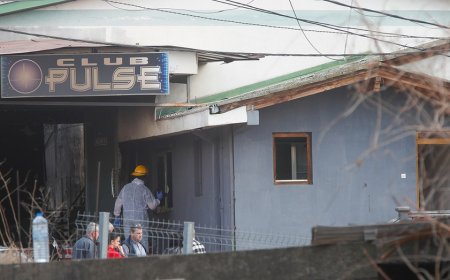Sierra Leone loves rice and wants to free itself from imports. But how to do it?
FREETOWN, Sierra Leone (AP) — Rice borders on the sacred in Sierra Leone. Unless a meal includes rice, people say, you haven’t eaten at all.But as prices soar, consumers in the West African nation are giving up other food to buy it. That's a major reason why 83% of the population is food insecure, according to the U.N.’s World Food Program.In the capital, Freetown, 28-year-old nail technician Anima Mangola dug into rice with stewed cassava leaves. “I’d eat rice five times a day if I had me the money," she said — even as its price has more than doubled this year.Not everyone can keep up, and “people are suffering,” she said.Experts blame soaring prices on a heavy reliance on imports, which supply 35% of Sierra Leone's rice and eat up $200 million annually in foreign currency.Even though West Africa has a long tradition of growing rice and often excellent places to do it, experts said the import dependency is due to a lack of investment in agriculture, booming population growth and cheap rice imports from Asia.Hub peek embed (Inflation) - Compressed layout (automatic embed) Sierra Leone's agriculture minister, Henry Kpaka Musa, accused the International Monetary Fund of pressuring Sierra Leone in the 1980s to stop investing in agriculture and open its markets to imports as a condition for receiving loans.“We used to export rice,” Kpaka said in an interview.Now he and President Julius Bio plan to do it again. The government has raised over $620 million from global development banks this year to work towards food self-sufficiency, notably in rice, although Kpaka estimated the plan will cost $1.8 billion in all. Experts from the Ivory Coast-based research center Africa Rice have commended the plan as “ambitious and forward-looking."But NGOs and academics warn it will favor international agribusiness and large-scale farms, to the detriment of the nation’s 5 million smallholder farms. They point to similar, failed attempts at food self-sufficiency in places such as Burkina Faso and Ghana.Self-sufficiency challenges and potentialWest Africa has an ancient rice tradition dating back an estimated back 3,500 years. Historian Judith Carney said its farmers were taken as slaves to work plantations in the U.S. South, giving birth to a booming rice economy.Sierra Leone has the region's best climate and land for growing rice, with abundant annual rainfall in coastal regions.But Kpaka, the minister, highlighted obstacles to rice self-sufficiency: poor roads to connect rice-growing areas with markets, unreliable electricity for processing, climate change and poor access to finance.With the financial backing from development banks, he has approved plans to improve roads to the country's three main “rice bowls," create large areas of irrigated land and provide fertilizers, seeds and pesticides to smallholder farms.“The plan starts with the infrastructure to attract the private sector to come," he said. He has promoted the plan to unspecified international investors, offering them thousands of hectares of irrigated land.But some believe smallholders, who make up 70% of the country’s population of 8 million, will be an afterthought.The view from the fieldAboubacar Kowa, a farming leader in Bo district, gathered others to discuss their rice challenges, which also included access to land and a lack of storage, training and processing capacity.They were united in their lack of optimism about government help. They’ve heard these ambitious plans before.“We don’t get support from the government,” said one smallholder and village chief, Eric Amara Manyeh.The most common concern was the lack of labor to create irrigated fields. Eliminating vegetation and digging channels is laborious, and an exodus of young people to urban areas means farmers have to employ laborers — a cost out of reach for many.Although unemployment is high in towns, Manyeh said young people prefer easier jobs such as driving motorbike taxis.Some farmers have formed collectives to share labor, but poor tools slow progress. In one government-backed project in Bo, digging 60 hectares (148 acres) of channels took three months by 82 people.A cautionary taleSierra Leone's goal to get chemical fertilizer, seeds and pesticides into the hands of smallholders is meant to replicate the Green Revolution in Asia, which increased rice production by over 100% in two decades.But Klara Fischer, a rural development professor at the Swedish University of Agricultural Sciences specializing in sub-Saharan Africa, warned that the approach exposes farmers to agribusiness giants such as Bayer Crop Science and Syngenta.An initiative called A Green Revolution for Africa. backed by the Gates Foundation, the Rockefeller Foundation and others, has spent over $1 billion since 2006 to increase access to fertilizers and seeds for smallholders, but its own evaluation in 2022 said it hasn’t increased food security. The initiative is supporting Sierra Leone's efforts.One recent assessment by the Germa

FREETOWN, Sierra Leone (AP) — Rice borders on the sacred in Sierra Leone. Unless a meal includes rice, people say, you haven’t eaten at all.
But as prices soar, consumers in the West African nation are giving up other food to buy it. That's a major reason why 83% of the population is food insecure, according to the U.N.’s World Food Program.
In the capital, Freetown, 28-year-old nail technician Anima Mangola dug into rice with stewed cassava leaves. “I’d eat rice five times a day if I had me the money," she said — even as its price has more than doubled this year.
Not everyone can keep up, and “people are suffering,” she said.
Experts blame soaring prices on a heavy reliance on imports, which supply 35% of Sierra Leone's rice and eat up $200 million annually in foreign currency.
Even though West Africa has a long tradition of growing rice and often excellent places to do it, experts said the import dependency is due to a lack of investment in agriculture, booming population growth and cheap rice imports from Asia.
Sierra Leone's agriculture minister, Henry Kpaka Musa, accused the International Monetary Fund of pressuring Sierra Leone in the 1980s to stop investing in agriculture and open its markets to imports as a condition for receiving loans.
“We used to export rice,” Kpaka said in an interview.
Now he and President Julius Bio plan to do it again. The government has raised over $620 million from global development banks this year to work towards food self-sufficiency, notably in rice, although Kpaka estimated the plan will cost $1.8 billion in all. Experts from the Ivory Coast-based research center Africa Rice have commended the plan as “ambitious and forward-looking."
But NGOs and academics warn it will favor international agribusiness and large-scale farms, to the detriment of the nation’s 5 million smallholder farms. They point to similar, failed attempts at food self-sufficiency in places such as Burkina Faso and Ghana.
West Africa has an ancient rice tradition dating back an estimated back 3,500 years. Historian Judith Carney said its farmers were taken as slaves to work plantations in the U.S. South, giving birth to a booming rice economy.
Sierra Leone has the region's best climate and land for growing rice, with abundant annual rainfall in coastal regions.
But Kpaka, the minister, highlighted obstacles to rice self-sufficiency: poor roads to connect rice-growing areas with markets, unreliable electricity for processing, climate change and poor access to finance.
With the financial backing from development banks, he has approved plans to improve roads to the country's three main “rice bowls," create large areas of irrigated land and provide fertilizers, seeds and pesticides to smallholder farms.
“The plan starts with the infrastructure to attract the private sector to come," he said. He has promoted the plan to unspecified international investors, offering them thousands of hectares of irrigated land.
But some believe smallholders, who make up 70% of the country’s population of 8 million, will be an afterthought.
Aboubacar Kowa, a farming leader in Bo district, gathered others to discuss their rice challenges, which also included access to land and a lack of storage, training and processing capacity.
They were united in their lack of optimism about government help. They’ve heard these ambitious plans before.
“We don’t get support from the government,” said one smallholder and village chief, Eric Amara Manyeh.
The most common concern was the lack of labor to create irrigated fields. Eliminating vegetation and digging channels is laborious, and an exodus of young people to urban areas means farmers have to employ laborers — a cost out of reach for many.
Although unemployment is high in towns, Manyeh said young people prefer easier jobs such as driving motorbike taxis.
Some farmers have formed collectives to share labor, but poor tools slow progress. In one government-backed project in Bo, digging 60 hectares (148 acres) of channels took three months by 82 people.
Sierra Leone's goal to get chemical fertilizer, seeds and pesticides into the hands of smallholders is meant to replicate the Green Revolution in Asia, which increased rice production by over 100% in two decades.
But Klara Fischer, a rural development professor at the Swedish University of Agricultural Sciences specializing in sub-Saharan Africa, warned that the approach exposes farmers to agribusiness giants such as Bayer Crop Science and Syngenta.
An initiative called A Green Revolution for Africa. backed by the Gates Foundation, the Rockefeller Foundation and others, has spent over $1 billion since 2006 to increase access to fertilizers and seeds for smallholders, but its own evaluation in 2022 said it hasn’t increased food security. The initiative is supporting Sierra Leone's efforts.
One recent assessment by the German development ministry in Ghana and Burkina Faso found no evidence that providing fertilizer and seeds increased yield or profit for smallholders, and found that 41% of rice farmers struggled to pay off their debts.
“These fertilizer and seed packages are entangled with private interests,” Fischer said. She also highlighted differences between Asia in the 1970s and the current situation in Africa. One is the cheap and available family labor in Asia compared to the rural exodus in Sierra Leone.
Kpaka, a former employee in the Gates Foundation's agricultural department, acknowledged concerns but was convinced his plan has the missing ingredient to unlock growth: the critical infrastructure to help farmers process and sell their rice, incentivizing them to grow more.
“If we don’t make the road, (farmers) will forever remain subsistence,” he said.
Others believe that Sierra Leone should spend its funding on measures that empower smallholder farms rather than big business.
Joseph Randall, director of an environmental NGO in Sierra Leone, Green Scenery, said the government should support sustainable practices such as organic compost instead of becoming dependent on imported chemical fertilizer, usually from Europe or North America, which contributes heavily to global warming.
Randall opposes the distribution of modern seeds, even though they are higher yielding. The hybrid varieties of rice can't be saved and replanted each year because they are bred by agribusinesses and have patents.
Meanwhile, in Manyeh’s village, thunder echoed through the chief’s rice fields. He pointed to a swamp that might be cultivated as part of the self-sufficiency goal.
“The willingness is there, the potential is there,” he said. But he knows it takes more than potential to feed a nation.
___
The Associated Press receives financial support for global health and development coverage in Africa from the Gates Foundation. The AP is solely responsible for all content. Find AP’s standards for working with philanthropies, a list of supporters and funded coverage areas at AP.org.


























































